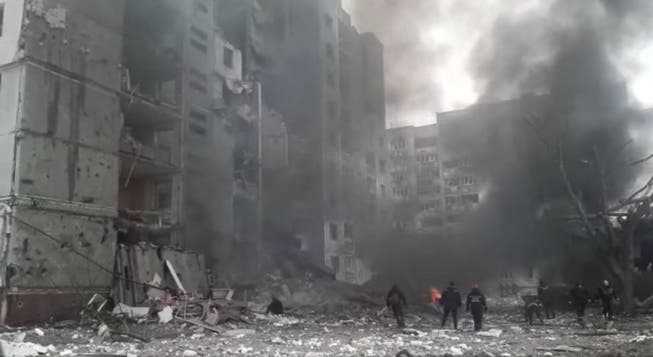The Ukrainian army continues to fight, but is unable to mount any sustained counterattacks. The Russian army continues to pursue its operational goals with all consistency.
The cities are being shot at, but capturing them completely is not the top priority at the moment. First, the Russian army wants to achieve the operational goals of the first phase of its offensive.
The war of images and words dominates the perception of the Russian attack on Ukraine. The coverage is focused on the cities and the brutality of the fighting in the built-up area. The strategic communication of the Ukrainian army has so far succeeded in emphasizing its own resilience. The Russian offensive, on the other hand, is weaker than expected.
The Ukrainians’ skilful information warfare draws attention away from the actual picture of the situation. On Thursday, the eighth day after the invasion, the interpretation of the available data and maps made the operational intention of the Russian army increasingly clear: In this first phase of the war, the aim is to seal off the capital Kyiv and at the same time the entire south take possession of the Black Sea coast.
The capture of the cities does not seem to have top priority everywhere. A large part of the armored forces follow the principle of “flowing water”. Obstacles are bypassed in order to reach the actual target of the attack as quickly as possible. This is clearly evident in the thrust from the north-east in the direction of Kyiv, where the Russian tanks initially bypassed the town of Konotop to the north and east. The leading associations want to set up new bases east and south of the city as soon as possible.
Missing offensive means of the Ukrainians
Together with the advance on both sides of the Dnipro, Kyiv would be almost completely surrounded. Only then would an effective storm towards the center of the capital be possible. But the Kremlin is likely to try to put moral pressure on the Ukrainian government first: Either you give up, or you have to take responsibility for the cruelty of the house-to-house fighting, could be the Kremlin’s cynical message.
The Russian army is proceeding in a similarly consistent manner in the south. Ukrainian troops are still resisting in Mariupol and Cherson. The back and forth of conflicting news about the situation in the two cities hides the real change in the situation: the Russian army has practically established a land connection between the separatist areas and the Crimean peninsula. Ukrainian resistance trapped in Mariupol.
In addition, the Russian troops were able to cross the Dnipro west of the Crimea and take possession of the most important crossing at Cherson undamaged. A strong bridgehead is probably being formed at present so that additional troops can push further towards Odessa. There are also said to be landing craft in front of the Crimea. The attack could therefore also be supported from the Black Sea.
So the offensive continues almost according to the textbook – probably slower than planned, but with all consistency. At the beginning, the Ukrainian army was able to slow down the Russian attack with a skillful defense. The latest technology combined with a strong will to defend initially put the Russians under pressure.
However, the Ukrainians lack the means to decisively beat back the Russian units with counterattacks, even if there are repeated reports of territory being regained. For effective, active defense, Ukrainian tanks are outdated, as is the air force. Despite a gradual modernization of the army, Kyiv has not managed to close the gaps in this area. In addition, the Russians have air superiority, including with the S-400 air defense system.
Dangerous development of the situation in the south-east?
Retired American general and former CIA director David Petraeus has said in various media outlets that Russian troops are running short of fuel and supplies. In addition, they are progressing far too slowly. Apparently, many vehicles in the convoy traveling west of the Dnipro are struggling with maintenance problems. There are also reports of problems with the connections. Individual associations communicated via unencrypted radios.
In fact, Western armies rely on significantly more security, networking and speed in their operations. However, the Russian army has brought so much military force to the Ukrainian border for its offensive that problems with radio traffic or logistics should be compensated for with the mass.
The possible development of the situation in the south-east of the country is threatening. The Russian army could encircle the Ukrainian troops from the south and east with a pincer attack in the area of the city of Kramatorsk. Because of their weak offensive resources, they could hardly dare to break out quickly and would probably have to give up the defense.
Conventional war in all its severity
French President Emmanuel Macron also painted a bleak picture on Thursday. After speaking to Russian President Vladimir Putin on the phone, he expressed concern that the worst was yet to come for Ukraine. Macron said Putin was very determined to occupy all of Ukraine.
So the Kremlin wants to get its way with a conventional ground war. Cyberattacks and other ambiguous means have receded into the background since Putin crossed the threshold of war. The danger that he will not respect other borders should not be underestimated. Nothing good can be expected from the course of the war so far.
